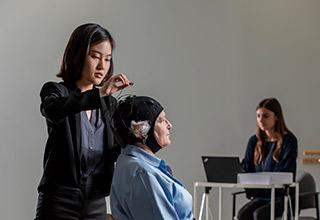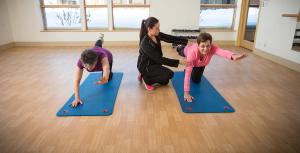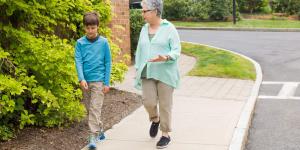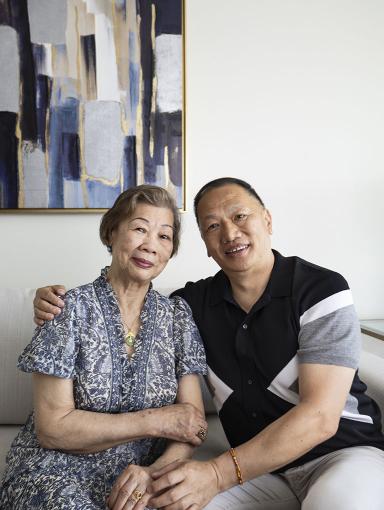PAVING the Path to Wellness: A Step-by-Step Approach to Healthy Living
Learn how Hebrew SeniorLife was the first organization to introduce this impactful wellness program to older adults in an independent living community.
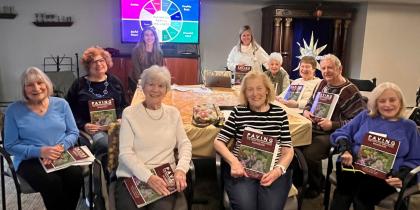
What does it mean to live well? Healthy living isn’t about eating less and exercising more — it’s about nourishing your body, mind, and spirit. Adopting habits like better nutrition and sleep, stress resiliency, and social support, plus having a goal-oriented action plan to make these healthy habits a reality, can empower you to thrive.
That’s the basis of the lifestyle medicine-inspired PAVING the Path to Wellness program, which I facilitate at Center Communities of Brookline as a certified PAVING leader.
What is lifestyle medicine?
Healthy aging is a lifelong process shaped by our daily choices. Lifestyle medicine is a medical approach that uses evidence-based lifestyle changes to prevent and treat chronic conditions. It focuses on six key pillars of health: a whole-food, plant-forward diet, physical activity, restorative sleep, stress management, avoidance of risky substances, and positive social connections.
Extensive research supports these pillars, and lifestyle medicine is an effective way to optimize the aging trajectory. But while many of us understand that getting a good night’s sleep is important, managing stress is crucial, and staying active offers several health benefits, putting these habits into practice can feel like a challenge. Life often gets in the way!
That’s where programs like PAVING the Path to Wellness can help bridge the gap. With structured guidance and group support, PAVING helps participants turn intention into meaningful action.
A practical approach to lifestyle changes
PAVING the Path to Wellness is a 12-week program based on the principles of lifestyle medicine. Initially launched in 2012 at Spaulding Rehabilitation Hospital to optimize health and recovery for stroke survivors, it has been adapted for other populations in the years since.
In 2024, Hebrew SeniorLife brought the PAVING program to Center Communities of Brookline. In doing so, we became the first organization in the country to offer the program to older adults living in an independent living community! The response has been exceptional, underscoring the value of lifestyle medicine and a supportive group program for older adults.
The PAVING program is built around a comprehensive framework called the PAVING STEPSS wheel, which includes 12 areas of growth and focus:
- Physical activity
- Attitude
- Variety
- Investigations
- Nutrition
- Goals
- Stress Resiliency
- Time Outs
- Energy
- Purpose
- Sleep
- Social Connection
Each weekly session focuses on a specific area of the PAVING STEPSS wheel. The pilot group of 10 participants met weekly for structured sessions that included a check-in to share progress, a discussion of the week’s pillar, and time for goal-setting.
Participants received a PAVING program workbook, which breaks the 12 steps into actionable strategies for making healthy lifestyle changes. Additionally, I authored a PAVING the Path to Wellness cookbook featuring simple and nutritious plant-based recipes designed to simplify plant-forward eating.
One pilot program participant, Center Communities resident Donna Elfman, describes PAVING as “a delightful experience.”
Donna decided to participate shortly after losing her husband. “I knew I needed something more in my life to continue caring for myself and not just be a caregiver. This was an important step on the road to caring for myself,” she explains.
PAVING helped Donna explore key lifestyle choices that can promote better health. “We did a lot of laughing and learning about basic everyday healthy habits that we didn’t know about — nutrition, sleep, activity level. So much so that everybody in my mahjong game now stands up after an hour or so. I’ve got everybody in the room standing up,” she says.
Myrna Offen was another participant who found the program valuable. “I used to work for a cardiologist for many years. I know a lot about medicine — probably more than most people. I had a wonderful husband who passed away a year ago, and had many trials and tribulations around health. This seemed like a good opportunity to learn something that I didn’t already know,” she explains.
She gained valuable insights into her own health. “It showed me, and I think others, that there was room for improvement around physical activity, energy, and other categories that I wouldn’t have thought of, like purpose and attitude,” she says.
The significance of social support
While every element of the PAVING STEPSS wheel is important for well-being, the social connections formed by the group have stood out for their impact. Social isolation and loneliness are widespread among older adults. Even though it’s been years since COVID-19 first emerged, over half of older adults still spend more time at home and less socializing in public than before the pandemic.
For Donna, the connections she formed in the group were significant. “The camaraderie with people who I don’t usually spend time with was good. We need to thrive with others, and I try to find joy every day with life, but I was just inspired by the program,” she explains.
The PAVING program is often virtual, but I knew the older adults at Hebrew SeniorLife would thrive in an in-person group setting. And they have! Our participants have a lifetime of knowledge and experience and are eager to share and encourage each other. Some participants began walking together, some started playing games, some went to museums together, and all enthusiastically supported and encouraged the rest of the members. Real friendships blossomed as a result of this program.
Social connection can even impact other aspects of overall well-being. For example, one study found a positive relationship between social support and sleep quality in older adults. Another linked perceived isolation with lower levels of self-rated physical health in older adults.
One of Myrna’s major takeaways from participating in PAVING is the importance of putting herself out there socially. That’s something that has stayed with her even though the program has ended. “A friend invited me and others to her apartment on New Year’s Eve to celebrate, and I got to know someone new in a different way. It was nice to get to know her. I’m more aware of how important friendships are and it made it easier for me to talk to this person at the party and to appreciate people more,” she says.
SMART goals help healthy habits take shape
Rather than being curative, the PAVING program aims to optimize health. Beyond the meaningful social connections that have formed, participants set and worked toward SMART goals to enrich their lives.
Donna’s goals involved fostering joy and knowing when to slow down. “I don’t have pets, but I did get a couple of orchids that are still thriving, so I have something to take care of and look at with joy each day. I’ve also learned to slow down my pace and not try to grab life with so much gusto that I’m too exhausted to do anything else,” she explains.
Participants take a questionnaire that flags areas of opportunity for their health. For example, one participant joined the program thinking they were physically active. Their questionnaire results made them realize they weren’t moving as much as they thought, so they set a SMART goal to walk outside several days weekly with a contingency plan for bad weather.
The “time outs” element of the wheel refers to the importance of taking breaks from unhealthy influences, prolonged sitting, difficult conversations, and negative self-talk. Taking a “time out” can increase your clarity and overall well-being. Donna’s efforts to take a break and stretch during rounds of mahjong is a great example of taking a “time out” from the harmful effects of too much sitting.
Of course, well-being isn’t just about physical health. Another participant was interested in infusing more joy into their life. They decided to create a goal centered around finding joy once per week. They went to museums and saw new artwork, and they are exploring taking a class at a senior center with another group member.
Innovative wellness care for older adults
With the pilot PAVING program an undeniable success, the second group is already underway. Given the residents’ interest, enthusiasm, and engagement, we’re hopeful to offer continued groups to residents of Center Communities and then more broadly across Hebrew SeniorLife.
PAVING the Path to Wellness is just one example of how the Center Communities team prioritizes the wellness of its residents. While the PAVING program emphasizes the pillars of lifestyle medicine in a small group setting, our innovative Right Care, Right Place, Right Time Initiative — also known as R3 — integrates health and well-being teams directly into our senior housing communities.
Our on-site health and well-being teams at Center Communities of Brookline, Jack Satter House in Revere, Simon C. Fireman Community in Randolph, and Leyland Community in Dorchester offer supportive services to residents to engage them around their well-being. At the core of the R3 is a trusted partnership that our health and well-being team cultivates with each resident, supporting them to address health and well-being priorities in a way that is proactive, prevention-driven, and empowering.
R3 empowers residents to manage their health so they can stay active and engaged in their community and live their best lives. We also partner with other senior affordable housing providers to bring R3 to their communities.
Interested in learning more about life in a wellness-focused community? Find a service or community today.
Join Our Community: Subscribe to the Hebrew SeniorLife blog for weekly insights on healthy aging and senior living.
Blog Topics
Learn More
Innovation at HSL
Whether we're making discoveries or developing new teaching methods, HSL continuously works to improve the lives of older adults.
